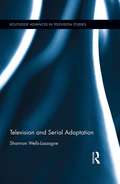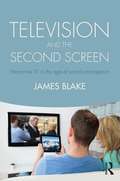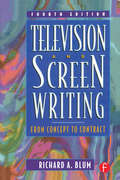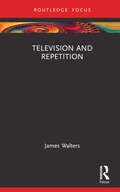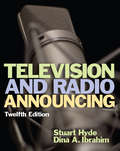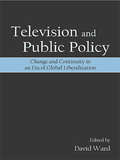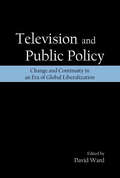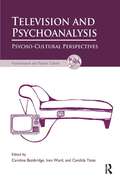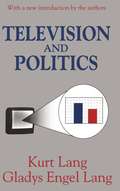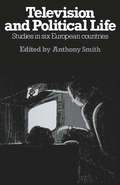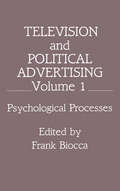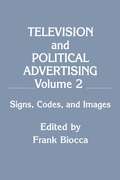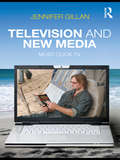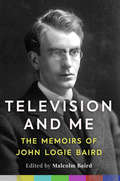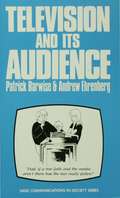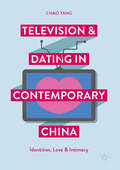- Table View
- List View
Television and Serial Adaptation (Routledge Advances in Television Studies)
by Shannon Wells-LassagneAs American television continues to garner considerable esteem, rivalling the seventh art in its "cinematic" aesthetics and the complexity of its narratives, one aspect of its development has been relatively unexamined. While film has long acknowledged its tendency to adapt, an ability that contributed to its status as narrative art (capable of translating canonical texts onto the screen), television adaptations have seemingly been relegated to the miniseries or classic serial. From remakes and reboots to transmedia storytelling, loose adaptations or adaptations which last but a single episode, the recycling of pre-existing narrative is a practice that is just as common in television as in film, and this text seeks to rectify that oversight, examining series from M*A*S*H to Game of Thrones, Pride and Prejudice to Castle.
Television And The Second Screen: Current Practices And Future Directions (PDF)
by James BlakeTelevision is changing almost beyond recognition. In the battle for consumers, social media sites, smart phones and tablets have become rivals to traditional linear TV. However, audiences and producers are also embracing mobile platforms to enhance TV viewing itself. This book examines the emerging phenomenon of the second screen: where users are increasingly engaging with content on two screens concurrently. The practice is transforming television into an interactive, participatory and social experience. James Blake examines interactive television from three crucial angles: audience motivation and agency, advances in TV production and the monetisation of second screen content. He also tracks its evolution by bringing together interviews with more than 25 television industry professionals - across the major UK channels - including commissioning editors, digital directors, producers and advertising executives. These reveal the successes and failures of recent experiments and the innovations in second screen projects. As the second screen becomes second nature for viewers and producers, the risks and opportunities for the future of television are slowly beginning to emerge. Television and the Second Screenwill offer students and scholars of television theory, industry professionals and anyone with an abiding interest in television and technology, an accessible and illuminating guide to this important cultural shift.
Television and Screen Writing: From Concept to Contract
by Richard A BlumNow in its fourth edition, Television and Screen Writing: From Concept to Contract is a classic resource for students and professionals in screenwriting and television writing. This book will teach you how to become a creative and marketable writer in every professional arena - including major studios, production companies, networks, cable and pay TV, animation, and interactive programs. Specific techniques and script samples for writing high-quality and producible "spec" scripts for theatrical motion pictures, the sitcom series, one-hour dramatic series, longform television, soaps, talk show, variety, animation, interactive and new media are provided. Television and Screen Writing: From Concept to Contract, Fourth Edition also offers a fully detailed examination of the current marketplace, and distinct strategies for marketing your scripts, from registering and copyrighting the script to signing with an agent. This new edition has been expanded to include the most up-to-date creative and professional script samples, marketing resources, and practical information possible. The companion website (www.focalpress.com/companions) offers a wide range of contacts and resources for you to explore, and Internet links to professional resources. There is also an Annotated and Selected Bibliography for your reference
Television and Screen Writing: From Concept to Contract
by Richard A BlumNow in its fourth edition, Television and Screen Writing: From Concept to Contract is a classic resource for students and professionals in screenwriting and television writing. This book will teach you how to become a creative and marketable writer in every professional arena - including major studios, production companies, networks, cable and pay TV, animation, and interactive programs. Specific techniques and script samples for writing high-quality and producible "spec" scripts for theatrical motion pictures, the sitcom series, one-hour dramatic series, longform television, soaps, talk show, variety, animation, interactive and new media are provided. Television and Screen Writing: From Concept to Contract, Fourth Edition also offers a fully detailed examination of the current marketplace, and distinct strategies for marketing your scripts, from registering and copyrighting the script to signing with an agent. This new edition has been expanded to include the most up-to-date creative and professional script samples, marketing resources, and practical information possible. The companion website (www.focalpress.com/companions) offers a wide range of contacts and resources for you to explore, and Internet links to professional resources. There is also an Annotated and Selected Bibliography for your reference
Television and Repetition
by James WaltersResisting some of the negative connotations that repetition can attract, this book illustrates how it has been used as a catalyst for creative expression across a range of television genres. Divided into two parts, the first three chapters contextualise repetition within related media and critical debates, before locating it as an important facet of television that is worth exploring in detail. The final three chapters discuss specific television shows that incorporate repetition creatively within their narrative structure and aesthetic composition, ranging from The Royle Family and Doctor Who to I May Destroy You and This is Going to Hurt. In each case, James Walters argues that repetition emerges as crucial to the expression of key themes and ideas, thus becoming a structural and compositional element itself. Exploring the ways in which repetition has featured in the work of figures such as Umberto Eco, Raymond Bellour and Bruce Kawin, and has influenced the approaches of television scholars like Raymond Williams, Roger Silverstone and John Ellis, this book is essential reading for scholars and students of film, television and media studies.
Television and Repetition
by James WaltersResisting some of the negative connotations that repetition can attract, this book illustrates how it has been used as a catalyst for creative expression across a range of television genres. Divided into two parts, the first three chapters contextualise repetition within related media and critical debates, before locating it as an important facet of television that is worth exploring in detail. The final three chapters discuss specific television shows that incorporate repetition creatively within their narrative structure and aesthetic composition, ranging from The Royle Family and Doctor Who to I May Destroy You and This is Going to Hurt. In each case, James Walters argues that repetition emerges as crucial to the expression of key themes and ideas, thus becoming a structural and compositional element itself. Exploring the ways in which repetition has featured in the work of figures such as Umberto Eco, Raymond Bellour and Bruce Kawin, and has influenced the approaches of television scholars like Raymond Williams, Roger Silverstone and John Ellis, this book is essential reading for scholars and students of film, television and media studies.
Television and Radio Announcing
by Stuart HydeThe digital revolution has significantly changed broadcast technology. The 12th edition of Television and Radio Announcing reflects new trends in the field, such as the reconfiguration of electronic media production practices and distribution models. The internet and social media have opened up new access to production and new methods of distribution, such as YouTube, Facebook, Twitter, and podcasts. The 12th edition addresses the realities of students who live in this new era. Learning GoalsUpon completing this book, readers will be able to: Develop essential announcing skills Understand new trends in the field
Television and Radio Announcing: Text With Audio Cd
by Stuart HydeThe digital revolution has significantly changed broadcast technology. The 12th edition of Television and Radio Announcing reflects new trends in the field, such as the reconfiguration of electronic media production practices and distribution models. The internet and social media have opened up new access to production and new methods of distribution, such as YouTube, Facebook, Twitter, and podcasts. The 12th edition addresses the realities of students who live in this new era. Learning GoalsUpon completing this book, readers will be able to: Develop essential announcing skills Understand new trends in the field
Television and Public Policy: Change and Continuity in an Era of Global Liberalization
by David WardThe significant changes that have swept the television industry over the last two decades, most notably a shift to deregulation in broadcast media, prompt a discussion on how to ensure that meaningful content is available to the viewer. Television and Public Policy analyzes the current state of television systems in a selected group of countries by exploring the political, economic, and technological factors that have shaped the sector in such a short span of time. Consequently, by positioning the television sector within issues of media policy and the regulatory framework, the book questions what these trends mean for television, and the historical, political, and cultural role in our societies. Television and Public Policy distinguishes itself in several ways:*It is a global project in its comparative scope and subject area. Contributors represent countries including Australia, Brazil, Canada, China, Egypt, India, Iran, Ireland, Israel, Italy, Japan, the Netherlands, New Zealand, Poland, the United Kingdom, and the United States.*It is contemporary and filled with information largely absent in current literature.*It offers original analysis of the contemporary television sector. This book speaks to a broad range of academics, postgraduate, and undergraduate students, and can serve as a key resource for courses ranging from media studies, to development studies, international relations, and law.
Television and Public Policy: Change and Continuity in an Era of Global Liberalization
by David WardThe significant changes that have swept the television industry over the last two decades, most notably a shift to deregulation in broadcast media, prompt a discussion on how to ensure that meaningful content is available to the viewer. Television and Public Policy analyzes the current state of television systems in a selected group of countries by exploring the political, economic, and technological factors that have shaped the sector in such a short span of time. Consequently, by positioning the television sector within issues of media policy and the regulatory framework, the book questions what these trends mean for television, and the historical, political, and cultural role in our societies. Television and Public Policy distinguishes itself in several ways:*It is a global project in its comparative scope and subject area. Contributors represent countries including Australia, Brazil, Canada, China, Egypt, India, Iran, Ireland, Israel, Italy, Japan, the Netherlands, New Zealand, Poland, the United Kingdom, and the United States.*It is contemporary and filled with information largely absent in current literature.*It offers original analysis of the contemporary television sector. This book speaks to a broad range of academics, postgraduate, and undergraduate students, and can serve as a key resource for courses ranging from media studies, to development studies, international relations, and law.
Television and Psychoanalysis: Psycho-Cultural Perspectives
by Caroline BainbridgeDespite the prominence of television in our everyday lives, psychoanalytic approaches to its significance and function are notoriously few and far between. This volume takes up perspectives from object relations theory and other psychoanalytic approaches to ask questions about the role of television as an object of the internal worlds of its viewers, and also addresses itself to a range of specific television programmes, ranging from Play School, through the plays of Jack Rosenthal to recent TV blockbuster series such as In Treatment. In addition, it considers the potential of television to open up new public spaces of therapeutic experience. Interviews with a TV producer and with the subject of a documentary expressly suggest that there is scope for television to make a positive therapeutic intervention in people's lives. At the same time, however, the pitfalls of reality programming are explored with reference to the politics of entertainment and the televisual values that heighten the drama of representation rather than emphasising the emotional experience of reality television participants and viewers.
Television and Psychoanalysis: Psycho-Cultural Perspectives (The\psychoanalysis And Popular Culture Ser.)
by Caroline Bainbridge Ivan Ward Candida YatesDespite the prominence of television in our everyday lives, psychoanalytic approaches to its significance and function are notoriously few and far between. This volume takes up perspectives from object relations theory and other psychoanalytic approaches to ask questions about the role of television as an object of the internal worlds of its viewers, and also addresses itself to a range of specific television programmes, ranging from Play School, through the plays of Jack Rosenthal to recent TV blockbuster series such as In Treatment. In addition, it considers the potential of television to open up new public spaces of therapeutic experience. Interviews with a TV producer and with the subject of a documentary expressly suggest that there is scope for television to make a positive therapeutic intervention in people's lives. At the same time, however, the pitfalls of reality programming are explored with reference to the politics of entertainment and the televisual values that heighten the drama of representation rather than emphasising the emotional experience of reality television participants and viewers.
Television and Politics
by Kurt Lang Gladys Engel Lang"The authorsahave analyzed the television problem brilliantly. They had come up with a whole set of new insights, and their backup research always is fascinating to read."-Saturday Review"A cautious, research-based bookahopefully it will set a trend."-Ithiel de Sola Pool, Public Opinion QuarterlyAfter more than forty years of studying its political implications, Kurt and Gladys Lang put the power of television into a unique perspective. Through carefully compiled case studies, they reveal surprising truths about TV's effect on American political life, and explode some popular myths. Their theme throughout is that television gives the viewer the illusion of being a favored spectator at some event-he "sees for himself," in other words. But, in fact, it conveys a reality different from that experienced by an eyewitness. Because the televised version of an event reaches more people, it has greater impact on the public memory and comes to overshadow what actually happened.The Langs tell in detail how television shapes events; how public figures and political institutions adjust their tactics to exploit the effects they-and millions of viewers-think television has. They examine such issues as whether or not network television projections influence election results. They consider the accuracy of the networks increasingly sophisticated techniques for "calling" election outcomes well before polls close. Such concerns have never been more at the forefront of the public consciousness than in the wake of the 2000 presidential election. The Langs assess the research to date and clarify the effects of early TV projections on voter turnout and election outcomes, and look at the implications for our system of government.A model of excellent policy analysis, this highly readable volume will interest decision-makers and analysts, as well as students of journalism, broadcasting, political behavior, and voters looking forward to the next election.Kurt Lang was a professor of sociology and political science at Stony Brook before becoming the Director of the School of Communications at the University of Washington. Gladys Engel Lang is a professor of communications with joint appointments in Political Science and Sociology at the University of Washington. In addition to Television and Politics, the Langs have also co-authored The Battle for Public Opinion: the President, the Press and the Polls during Watergate, Voting and Nonvoting, and Collective Dynamics.
Television and Politics
by Kurt Lang Gladys Engel Lang"The authorsahave analyzed the television problem brilliantly. They had come up with a whole set of new insights, and their backup research always is fascinating to read."-Saturday Review"A cautious, research-based bookahopefully it will set a trend."-Ithiel de Sola Pool, Public Opinion QuarterlyAfter more than forty years of studying its political implications, Kurt and Gladys Lang put the power of television into a unique perspective. Through carefully compiled case studies, they reveal surprising truths about TV's effect on American political life, and explode some popular myths. Their theme throughout is that television gives the viewer the illusion of being a favored spectator at some event-he "sees for himself," in other words. But, in fact, it conveys a reality different from that experienced by an eyewitness. Because the televised version of an event reaches more people, it has greater impact on the public memory and comes to overshadow what actually happened.The Langs tell in detail how television shapes events; how public figures and political institutions adjust their tactics to exploit the effects they-and millions of viewers-think television has. They examine such issues as whether or not network television projections influence election results. They consider the accuracy of the networks increasingly sophisticated techniques for "calling" election outcomes well before polls close. Such concerns have never been more at the forefront of the public consciousness than in the wake of the 2000 presidential election. The Langs assess the research to date and clarify the effects of early TV projections on voter turnout and election outcomes, and look at the implications for our system of government.A model of excellent policy analysis, this highly readable volume will interest decision-makers and analysts, as well as students of journalism, broadcasting, political behavior, and voters looking forward to the next election.Kurt Lang was a professor of sociology and political science at Stony Brook before becoming the Director of the School of Communications at the University of Washington. Gladys Engel Lang is a professor of communications with joint appointments in Political Science and Sociology at the University of Washington. In addition to Television and Politics, the Langs have also co-authored The Battle for Public Opinion: the President, the Press and the Polls during Watergate, Voting and Nonvoting, and Collective Dynamics.
Television and Political Advertising: Volume I: Psychological Processes (Routledge Communication Series)
by Frank BioccaThis volume represents one of the first major scholarly effort to unravel the psychological and symbolic processing of political advertising. Utilizing survey, experimental, qualitative, and semiotic methodologies to study this phenomenon, the contributors to Television and Political Advertising trace how political ads help to interpret the psychological reality of the presidential campaign in the minds of millions of voters. A product of the National Political Advertising Research Project, this interdisciplinary effort is valuable to researchers in advertising, communication, and consumer psychology since it helps define future work on the relationship between television, politics, and the mind of the voter. This volume, Television and Political Advertising: Psychological Processes, is the first of two, and covers such topics as Models and Theories for Viewing Political Television; Psychological Processing of Issues, Images, and Form; Differential Processing of Positive and Negative Advertising; and The Psychological Contexts of Processing.
Television and Political Advertising: Volume I: Psychological Processes (Routledge Communication Series)
by Frank BioccaThis volume represents one of the first major scholarly effort to unravel the psychological and symbolic processing of political advertising. Utilizing survey, experimental, qualitative, and semiotic methodologies to study this phenomenon, the contributors to Television and Political Advertising trace how political ads help to interpret the psychological reality of the presidential campaign in the minds of millions of voters. A product of the National Political Advertising Research Project, this interdisciplinary effort is valuable to researchers in advertising, communication, and consumer psychology since it helps define future work on the relationship between television, politics, and the mind of the voter. This volume, Television and Political Advertising: Psychological Processes, is the first of two, and covers such topics as Models and Theories for Viewing Political Television; Psychological Processing of Issues, Images, and Form; Differential Processing of Positive and Negative Advertising; and The Psychological Contexts of Processing.
Television and Political Advertising: Volume Ii: Signs, Codes, and Images (Routledge Communication Series)
by Frank BioccaThis volume represents one of the first major scholarly efforts to unravel the psychological and symbolic processing of political advertising. Utilizing survey, experimental, qualitative, and semiotic methodologies to study this phenomenon, the contributors to Television and Political Advertising trace how political ads help to interpret the psychological reality of the presidential campaign in the minds of millions of voters. A product of the National Political Advertising Research Project, this interdisciplinary effort is valuable to researchers in advertising, communication, and consumer psychology since it helps define future work on the relationship between television, politics, and the mind of the voter. This volume, Television and Political Advertising: Signs, Codes and Images, is the second of two, and covers such areas as Generating Meaning in the Pursuit of Power, Analyses of the Meaning of Political Ads, The Campaign Documentary as an Ad, and Regulating Signs and Images.
Television and Political Advertising: Volume Ii: Signs, Codes, and Images (Routledge Communication Series)
by Frank BioccaThis volume represents one of the first major scholarly efforts to unravel the psychological and symbolic processing of political advertising. Utilizing survey, experimental, qualitative, and semiotic methodologies to study this phenomenon, the contributors to Television and Political Advertising trace how political ads help to interpret the psychological reality of the presidential campaign in the minds of millions of voters. A product of the National Political Advertising Research Project, this interdisciplinary effort is valuable to researchers in advertising, communication, and consumer psychology since it helps define future work on the relationship between television, politics, and the mind of the voter. This volume, Television and Political Advertising: Signs, Codes and Images, is the second of two, and covers such areas as Generating Meaning in the Pursuit of Power, Analyses of the Meaning of Political Ads, The Campaign Documentary as an Ad, and Regulating Signs and Images.
Television and New Media: Must-Click TV
by Jennifer GillanWe watch TV on computers, phones, and other mobile devices; television is now online as much as it is "on air." Television and New Media introduces readers to the ways that new media technologies have transformed contemporary broadcast television production, scheduling, distribution, and reception practices. Drawing upon recent examples including Lost, 24, and Heroes, this book examines the ways that television programming has changed—transforming nearly every TV series into a franchise, whose on-air, online, and on-mobile elements are created simultaneously and held together through a combination of transmedia marketing and storytelling. Television studios strive to keep their audiences in constant interaction with elements of the show franchise in between airings not only to boost ratings, but also to move viewers through the different divisions of a media conglomerate. Organized around key industrial terms—platforming, networking, tracking, timeshifting, placeshifting, schedule-shifting, micro-segmenting, and channel branding this book is essential for understanding how creative and industrial forces have worked together to transform the way we watch TV.
Television and New Media: Must-Click TV
by Jennifer GillanWe watch TV on computers, phones, and other mobile devices; television is now online as much as it is "on air." Television and New Media introduces readers to the ways that new media technologies have transformed contemporary broadcast television production, scheduling, distribution, and reception practices. Drawing upon recent examples including Lost, 24, and Heroes, this book examines the ways that television programming has changed—transforming nearly every TV series into a franchise, whose on-air, online, and on-mobile elements are created simultaneously and held together through a combination of transmedia marketing and storytelling. Television studios strive to keep their audiences in constant interaction with elements of the show franchise in between airings not only to boost ratings, but also to move viewers through the different divisions of a media conglomerate. Organized around key industrial terms—platforming, networking, tracking, timeshifting, placeshifting, schedule-shifting, micro-segmenting, and channel branding this book is essential for understanding how creative and industrial forces have worked together to transform the way we watch TV.
Television and Me: The Memoirs of John Logie Baird
by John Logie Baird‘A fabulous distillation of all the joy and bitterness, hurt and humour of an extraordinary man… I doubt there will be a better written, more interesting or important book published in Scotland this year.’— Daily Mail (2004)‘Funds were going down, the situation was becoming desperate and we were down to our last £30 when at last, one Friday in the first week of October 1925, everything functioned properly. The image of the dummy’s head formed itself on the screen with what appeared to me almost unbelievable clarity. I had got it! I could scarcely believe my eyes, and felt myself shaking with excitement.’In one of the most extraordinary and entertaining autobiographies to be written by any scientist or inventor, John Logie Baird tells the story of his life and the scientific journey which led to the creation of television. He writes with blunt candour and caustic wit about his childhood in Scotland and the wild escapades of his early business career, when he marketed his own patent brand of medicated undersocks, failed in a hilarious attempt to set up a jam-making factory in the Caribbean and went on to sell soap wholesale. Then he gives the definitive account of the epoch-making experiments through which television was created, and his later troubled relationship with the fledgling BBC and his bête noir, Lord Reith, who disliked television. The BBC obstructed and snubbed Baird at every opportunity.Some of his commercial and scientific rivals made a concerted attempt to discredit his status as the central figure in the invention of television, and even today, this has led to his importance being misunderstood. This new edition of his grippingly readable autobiography, edited and introduced by Baird’s only son, Malcolm, will help to set the record straight.
Television and Its Audience
by Professor Andrew Ehrenberg Professor Patrick BarwiseThis book by two leading experts takes a fresh look at the nature of television, starting from an audience perspective. It draws on over twenty years of research about the audience in the United States and Britain and about the many ways in which television is funded and organized around the world. The overall picture which emerges is of: a medium which is watched for several hours a day but usually at only a low level of involvement; an audience which views mainly for relaxation but which actively chooses favourite programmes; a flowering of new channels but with no fundamental change in what or how people watch; programmes costing millions to produce but only a few pennies to view; a wide range of programme types apparently similar to the range of print media but with nothing like the same degree of audience 'segmentation'; a global communication medium of dazzling scale, speed, and impact but which is slow at conveying complex information and perhaps less powerful than generally assumed. The book is packed with information and insights yet is highly readable. It is unique in relating so many of the issues raised by television to how we watch it. There is also a highly regarded appendix on advertising, as well as technical notes, a glossary, and references for further reading.
Television and Dating in Contemporary China: Identities, Love and Intimacy
by Chao YangThis book considers the changing nature of intimacy in contemporary China, providing a unique case study of romantic subjectivities in young people in the world’s fastest growing economy. Since the implementation of reform in 1978, the economic and socio-cultural environment of modern China has experienced a dramatic transformation under the influence of urbanization and globalization, facilitating more individualized identity among Chinese youth. This book bridges the gap between an emergent emphasis on individualisation and the country’s traditional norms and values. It focuses on young people’s understandings of various forms of relationships such as cohabitation, extramarital relationships and multiple relationships, suggesting a challenge to traditional familial values and an increasingly diversified understanding of the concepts of love and romance. By examining the formation of relationships among 21st century Chinese youth, notably through the lens of popular Chinese TV dating programs, this book considers how dating and relationships mirror China’s changing societal structure and examines social and cultural transformations in Chinese society.
Television and Dating in Contemporary China: Identities, Love and Intimacy
by Chao YangThis book considers the changing nature of intimacy in contemporary China, providing a unique case study of romantic subjectivities in young people in the world’s fastest growing economy. Since the implementation of reform in 1978, the economic and socio-cultural environment of modern China has experienced a dramatic transformation under the influence of urbanization and globalization, facilitating more individualized identity among Chinese youth. This book bridges the gap between an emergent emphasis on individualisation and the country’s traditional norms and values. It focuses on young people’s understandings of various forms of relationships such as cohabitation, extramarital relationships and multiple relationships, suggesting a challenge to traditional familial values and an increasingly diversified understanding of the concepts of love and romance. By examining the formation of relationships among 21st century Chinese youth, notably through the lens of popular Chinese TV dating programs, this book considers how dating and relationships mirror China’s changing societal structure and examines social and cultural transformations in Chinese society.
